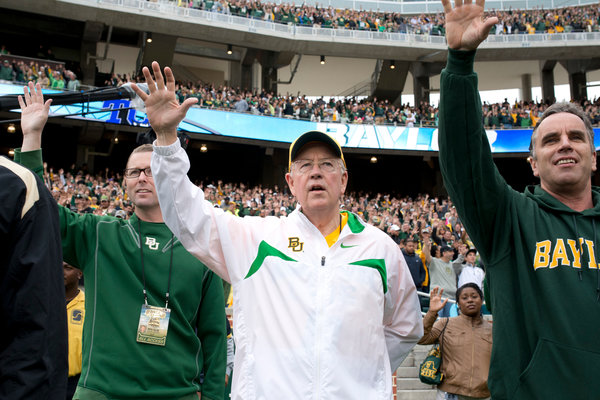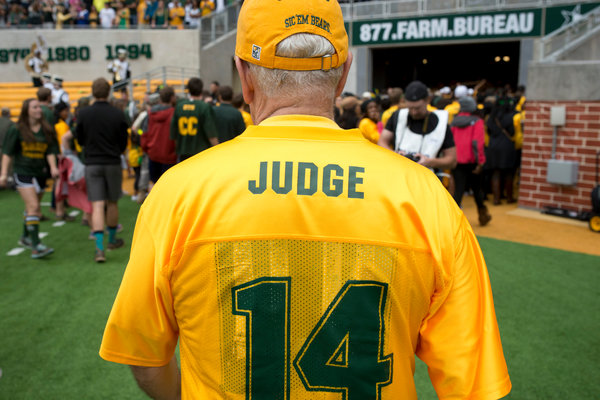
WACO, Tex. — Kenneth W. Starr stepped onto Baylor’s football field before a game last month wearing a track suit. He looked in better shape — less paunchy, less stressed — than he did more than 15 years ago, when he became famous for investigating a sitting president.
After greeting fans and hugging Bruiser the Bear, Mr. Starr, Baylor’s president, took his position on a corner of the field in front of thousands of freshmen. On a signal, he fixed his right hand into a bear claw symbol and led them in a raucous sprint across the field.
While Mr. Starr has spent the past decade in academia, sports have made being president of a university in one of the high-profile athletic conferences a political job, and lately he has returned to the corridors of power to defend the establishment.
In the past year, House and Senate committees have held hearings on the most contentious issue in college sports, whether to pay athletes, and the National Labor Relations Board said that it would review a regional director’s finding that Northwestern football players are employees who may unionize.

“I love D.C.,” Mr. Starr, 68, said. “I love the whole process of government, even when it’s not very pretty.”
He added, “I actually enjoy — I enjoy the arena.”
Many remember Mr. Starr from his days as independent counsel, when he delivered a report to Congress that chronicled President Bill Clinton’s dalliance with Monica Lewinsky, a White House intern. They would strain to recognize him in university life, where he is viewed as a goofy professor.
“We love him,” Gracie Millard, a freshman, said. “Around campus, people take selfies with him.”
Echoing several other undergraduates born in the mid-1990s, Ms. Millard added, “I didn’t know he was big in D.C.”
In August, as the N.C.A.A. prepared to approve greater autonomy for five major conferences, Mr. Starr argued on MSNBC’s “Morning Joe” that universities were reforming themselves. In May, on Capitol Hill, he testified against unionization in a hearing that took on a partisan color.
Several lawsuits, as well as the Northwestern case, could end up in the federal appellate system. For the powers that be in intercollegiate athletics, having Mr. Starr on their side is a little like learning that LeBron James is on your pickup basketball team.
“When you’re talking about laying the foundation for appellate cases, Ken Starr is your man,” said Ken Gormley, the dean of the Duquesne University School of Law and author of “The Death of American Virtue: Clinton vs. Starr.” “There’s only a handful of people in the country whose presence commands the attention of the Supreme Court itself and makes it more likely they will hear your case and that you will win, and he is one.” (When Mr. Starr was solicitor general, his principal deputy was John G. Roberts Jr., now the chief justice.)
It is unclear whether Mr. Starr wanted to be back in this spotlight. A Republican, he became a more partisan figure than even some elected officials. Many remember the Starr report for its most sordid details, and he later expressed conflicted feelings about the investigation, telling Mr. Gormley that if he were to run into Mr. Clinton he would probably say, “I’m sorry that it all happened.”
Mr. Starr’s biography on the Baylor website devotes only one paragraph to his quarter-century career in the nation’s capital as a federal appellate judge and the solicitor general, among other things, and a single sentence to his role as a Justice Department-appointed independent counsel who investigated a failed Arkansas real estate venture known as Whitewater, in which Mr. Clinton was an investor. The wide-ranging inquiry eventually revealed the relationship with Ms. Lewinksy and served as the basis for Mr. Clinton’s impeachment. Mr. Starr moved to Malibu, Calif., and became dean of the Pepperdine University School of Law in 2004, then moved in 2010 to dusty Waco, a few hours up Interstate 35 from San Antonio, his hometown.
“I think he sought solace in Texas during the rough times,” Mr. Gormley said.

Yet Mr. Starr articulates no regret for the surprisingly political position he has found himself in. A debut stage for so many athletes, college sports have given Mr. Starr’s public life a second act. He restored stability to Baylor, the country’s largest Baptist university, after becoming its fifth president in six years, including interims, and twice used his legal experience to help hold the Big 12 together amid the storms of realignment.
“He’s already an epic and transformational figure,” said Don Willett, a Texas Supreme Court justice and active Baylor alumnus.
The athletics department had been worse than unstable. In 2003, a men’s basketball player was murdered by a teammate, and in the aftermath payments to players and drug use within the program were exposed. The N.C.A.A. put the department on severe probation, which concluded less than two weeks before Mr. Starr arrived.
Scott Drew, who became the men’s basketball coach after the scandal, described the arc of Baylor athletics as “from the low to the high.”
The highs have been stratospheric. Three seasons ago, quarterback Robert Griffin III won the Heisman Trophy; the men’s basketball team reached the N.C.A.A. tournament’s Round of 8; and the women’s basketball team, led by Brittney Griner, went 40-0 and won the N.C.A.A. championship.
“Athletics strongly supports the sense of engagement in the community — in the polis,” Mr. Starr said before Baylor, the defending Big 12 football champion, scored 24 consecutive points in the fourth quarter to beat Texas Christian, 61-58, on Oct. 11. No. 10 Baylor (7-1) will face No. 16 Oklahoma (6-2) on Saturday.
Baylor is representative of the college sports landscape, in which realignment, billion-dollar television contracts and lucrative postseasons have induced smaller, private universities to bolster their football programs. With its Christian mission, golden dome atop Pat Neff Hall and talented football team, Baylor appears to be an especially faithful rendition of the original mold, Notre Dame.
Among the 65 universities in the five highest-profile conferences, 12 are private — essentially a conference’s worth. They would be directly affected if the N.L.R.B. affirmed that Northwestern players were employees. (Whether the case reaches the courts depends on several variables, including if Northwestern players voted in favor of a union in a secret vote, the results of which have yet to be released.)
Critics contend that unionization would professionalize what should be a primarily academic experience. They say that the regional director’s decision did not account for the fact that the players were students, complete with grade requirements — “an irreducible condition precedent to the entire relationship,” as Mr. Starr put it in May.
An amicus brief in the Northwestern case filed by Baylor and other private universities cited “the Roman poet Juvenal, whose phrase ‘mens sana in corpore sano’ (a sound mind in a sound body) encapsulates the logic for athletics in academia.” It urged the N.L.R.B. not to intervene because reforms like autonomy would solve most problems.
Though written by outside counsel, the brief bore Mr. Starr’s fingerprints. (The Latin quotation, particularly, is a calling card, Mr. Gormley said.) Mr. Starr acknowledged he looked it over.

Ramogi Huma, president of the National College Players Association, the advocacy group that sought to unionize Northwestern players, dismissed the suggestion that the student-athlete ideal by definition meant athletes could not unionize.
“I don’t think it’s credible to say students can only be educated if they’re not employees,” he said.
At the House hearing, Mr. Starr was asked about Baylor athletes’ graduation rates — its football Graduation Success Rate is a middling 72 percent — and whether Baylor complied with Title IX. He said later that it did.
Another bullet point in Mr. Starr’s case for amateurism was that sports do not “generate profits for Baylor — nor for most institutions of higher education.”
On the other hand, Mr. Starr enthusiastically said that sports were a boon to the university. “Success in athletics,” he said in an interview, “means that all boats rise.”
He may as well have been speaking of the boats in the man-made cove outside McLane Stadium, because the new stadium spurred a nearly $350 million capital campaign that also helped finance a new business school campus and a $100 million scholarship endowment.
Drayton McLane Jr., a former Houston Astros owner and a Baylor alumnus, said Mr. Starr wanted to raise money for scholarships first but was persuaded that raising money for athletics would have “a synergistic effect.”
Mr. Starr said, “It encouraged, frankly, the spirit of generosity — that seed to bear fruit — that otherwise would not have occurred.”
Opponents of amateurism view what Mr. Starr calls “cross-subsidizing” as hypocrisy. By contrast, Mr. Starr premises perhaps his most impassioned defense of amateurism upon it.
“We invite them to become part of a university community,” he said of athletes, “and we want you to be interested in that.”
It is an argument that, at the very least, jibes with Mr. Starr, who exhorts every football player individually as they walk to the stadium to psych up the “polis.”
Mr. Starr denied that his time as independent counsel was a “bruising experience,” as Mr. Gormley called it.
“I don’t use those words,” Mr. Starr said. “But I do like your use of those terms because our mascot is Bruiser!”